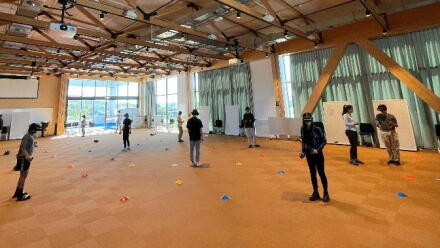Virtual reality simulations for physics and STEM education

Impact Focus areas
Research area
Learning in STEM disciplines often requires imagining abstract concepts such as electric fields and force fields, and correcting misconceptions arising from a student’s everyday intuitive perception of the world. Virtual (and Augmented) Reality (VR) offers a unique opportunity to give students the ability to visualise and experience these abstract objects and concepts. With the advent of high-quality, fully-immersive room-scale VR, accessibility to these abstract worlds has never been greater. Researchers at The Australian National University (ANU) have developed two sets of VR applications (Field VR, Dissonance VR) to assist with understanding difficult STEM concepts. Introduction of engaging learning tools into the school curriculum and university courses provides a mechanism to facilitate student retention, science literacy and maximise the potential of future generations of scientists.
Technology (T2018-024) Software features
- Simulation software developed by Lightning Rock
- Originally developed for the HTC Vive Headset
- Two key apps, available on Oculus Quest or any Steam VR compatible headset
- App 1: Field-VR (v.3) for visualising and experimenting with EM-fields in Multi-user environments.
- App 2: Dissonance-VR targets and corrects misconceptions students have about forces and motion
Figure 1: Field VR (left); Dissonance VR (right)
Potential benefits
- Improved engagement: Increased engagement, learning and retention leading to better educational outcomes in STEM, with over a 45% improvement in learning for those that used VR for just 30 mins.
- Integration of new technology in education: Gamification of smart education methods and learning solutions over traditional teaching tools.
- Ease of use and versatility: Extremely versatile software allows educators to easily design and offer a wide range of tailored lessons without additional programming background and support.
- Variety of learning simulations: Educators can tap into a range of educational simulations to visualise different scientific concepts in 3D (eg: Forces, magnetic fields, electric fields, vector fields, and simulated particle motion.)
Potential applications
- Education, Learning and Development
- Interactive Training Modules
- Aerospace & Military
- Secondary and Tertiary Education.
- Distance/remote Learning.
- VR Gaming Industry
Opportunity
ANU is seeking interested educational institutions and potential commercial R&D partnerships to test the software and provide feedback with potential licencing options or using a subscription model for software usage.
IP status
The software and its related IP is owned by the ANU
Key research team
- John Debs, Researcher, Research School of Physics
- Paul Benjamin Wigley, Department of Quantum Science, Research School of Physics



